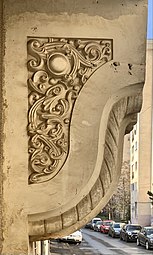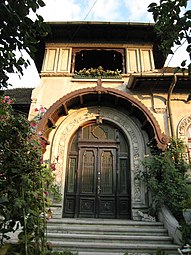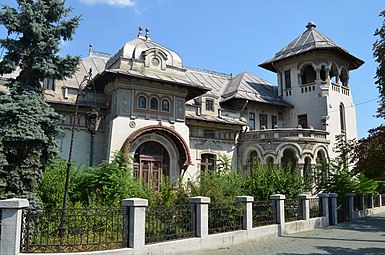Romanian Revival architecture
  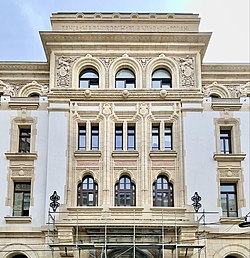 Top: The Cihoski House in Bucharest (Romania); Centre: The Cloister of the Stavropoleos Monastery by Ion Mincu, in Bucharest; Bottom: The in Bucharest | |
| Years active | late 19th century–first half of the 20th century |
|---|---|
Romanian Revival architecture (a.k.a. Romanian National Style, Neo-Romanian, or Neo-Brâncovenesc; Romanian: stilul național român, arhitectura neoromânească, neobrâncovenească) is an architectural style that has appeared in late 19th century in Romanian Art Nouveau,[1] initially being the result of the attempts of finding a specific Romanian architectural style. The attempts are mainly due to the architects Ion Mincu (1852–1912), and (1856–1924). The peak of the style was the interwar period. The style was a national reaction after the domination of French-inspired Classicist Eclecticism. Apart from foreign influences, the contribution of Romanian architects, who reinvented the tradition, creating, at the same time, an original style, is manifesting more and more strongly.[2] Ion Mincu and his successors, , Cristofi Cerchez, Petre Antonescu, or Nicolae Ghica-Budești declared themselves for a modern architecture, with Romanian specific, based on theses such as those formulated by Alexandru Odobescu around 1870:
"Study the remains – no matter how small – of the artistic production of the past and make them the source of a great art (...) do not miss any opportunity to use the artistic elements presented by the Romanian monuments left over from old times; but transform them, change them, develop them ..."
Of course, such a program was not easy to accomplish. All the more so as the new types of urban architecture, especially those with many floors, demanded simple solutions, which hardly supported the world of medieval forms and ornaments or that of folklore, the main sources of inspiration of the style.
19th century nationalism combined without problems with Europeanism and admiration for the West, Romania wanting to prove that it is a European country. After 1900, without abandoning European trends, the emphasis is more on values with Romanian specificity. As a result, the Parisian and Viennese buildings of the late nineteenth century are contrasted with a "Romanian style". The popularity of the Romanian style continues and intensifies in the interwar period.[3]
Origins[]

The Potlogi Palace (Dâmbovița County, Romania), 17th century

The main building of the Mogoșoaia Palace (Mogoșoaia, Romania), 17th-18th centuries

The Stavropoleos Church (downtown Bucharest), with elaborate paintings on the façade, 1724
Romanian Revival architecture is a revival of the Brâncovenesc [brɨŋkovenesk], a style in medieval Romanian art and architecture, more specifically in Wallachia during the reign of Constantin Brâncoveanu (1688–1714). This is because it was seen as the style specific to Romania, which is true. Brâncovenesc buildings are characterised by the use of gazebo-like porticos (mainly the entrances of churches), trilobate or kokoshnik arches, columns (usually Corinthian) with twisted flutings, and ceramic or metallic tile roof. The main ornament used for decoration are the interlace and the rinceau. Some of the features of Brâncovenesc architecture derive from Byzantine and Ottoman architecture, and a some can also be found in medieval Russian architecture.
Brâncovenesc churches usually have minimalistic façades with reliefs, most churches being white, while some have elaborate paintings on the façades (like the Stavropoleos Monastery from Bucharest), or brickwork (like the Kretzulescu Church from Bucharest). The walls of their interiors are filled with Byzantine style frescos. Above their main door there is a pisanie, which is an inscribed stone plaque. The inscription usually includes a religious invocation, the name of the founder or founders, the date of construction, the motivation of the building, the circumstances of the time and other data.
Characteristics[]

Polychrome glazed ceramic ornaments of a window of the (Bucharest)

Trilobate arch door with balcony of a house on Intrarea Rigas (Bucharest)
The Radu Stanian House (Ploiești), with many Romanian Revival elements, such as tin roofs, edges as eaves of peasant houses, a wooden awning, and other ones

Black-and-white photo from circa 1925 of the Primary Teachers House of Ploiești, by Toma T. Socolescu, with a tiled roof
The influences of peasant houses were manifested through ornaments and elements used under various interpretations, but which retain their origin. Some elements include the gazebo, the trilobate arch, wooden pillars, a treatment of the roof edges as eaves of peasant houses, big tiled or tin roofs, carved wooden awnings, and the use of polychrome glazed ceramics on façades. Commonly used ornaments include knots and ropes, and columns with twisted flutings.[4]
In some cases, especially at some churches, the Romanian Revival style is combined with the Armenian Revival one, both being similar. This category includes the and , both in Bucharest. Other buildings may have a strong Byzantine Revival influence. The Romanian Romanian style is similar in many ways to the Russian Revival one.
Representative architects[]
Ion Mincu[]

The , now in the courtyard of the Cantacuzino Hospital in Bucharest (1884-1886), Strada Ion Movilă no. 5
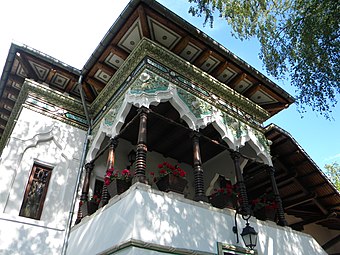
The gazebo of the in Bucharest (1889-1892), Șoseaua Kiseleff no. 4, now the Casa Doina Restaurant
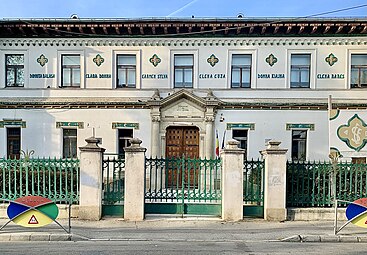
The Central Girls' School in Bucharest (1890-1894), Strada Icoanei no. 3-5
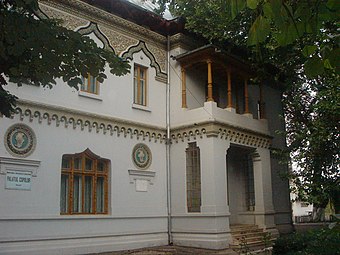
The in Galați (1896-1897), Strada Mihai Bravu no. 28

General School No. 11 in București (1900), Șoseaua Kiseleff no. 5
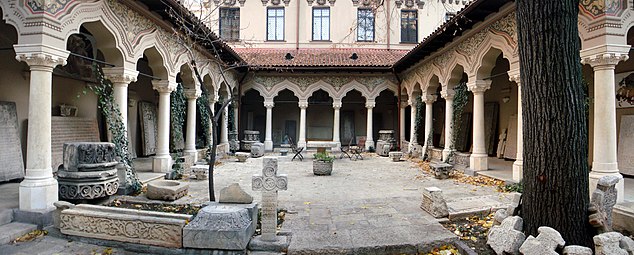
The Cloister of the Stavropoleos Monastery in Bucharest (1904), Strada Poștei no. 6
The Galați County Prefecture (1904-1905), Strada Domnească no. 56
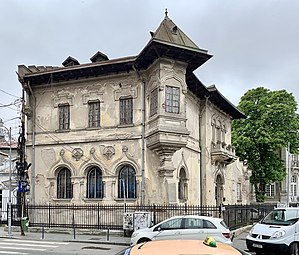
The Nicolae Petrașcu House (1907), Piața Romană no. 1
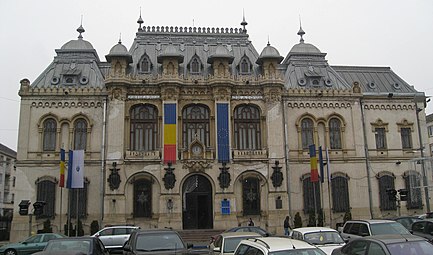
The in Craiova (finished by in 1916), Strada Alexandru Ioan Cuza no. 7, now the Craiova City Hall
His first attempts in Bucharest, after his return from studies in Paris, were the (1884–1886), the (1889–1892) and the Central Girls' School (1890–1894). They effectively marked the birth of Romanian Revival architecture with all the persistence of eclectic or, in general, historical tendencies. From this point of view, the Buffet is very characteristic, being one of the most successful buildings (initially designed as a Romanian pavilion at the 1889 Paris Universal Exposition), which is, on the whole, in line with the balance of Brâncovenesc architecture. Its most expressive element remains the gazebo: eight wooden pillars, connected with wooden beams, support a large masonry superstructure (trilobate arches in the shape of braces/kokoshniks and a complete entablature). The impression is also accentuated by the strong embossed ornamentation, made of polychrome glazed ceramics. Above the protruding cornice of the ceramic entablature, wooden pieces appear again: the ends of the transverse beams and the corbels that hold the very wide eaves of the roof. And as important spaces remain visible between the beams and corbels, the roof - large, high and covered with tiles - seems suspended. Eclectic elements appear in the ceramic ornamentation: Classicist geometric motifs or Renaissance floral motifs (but interpreted wavy, in the Art Nouveau spirit), which cover the entire surface of the gazebo masonry and the technique itself, of the high relief, colored in white, blue and ocher, of the Luca della Robbia type, contrasts with the relative sobriety of the old Romanian architecture from which, obviously, it started. Thus, the Buffet has a happy, lively and, especially, Romanian air.[5]
Petre Antonescu[]

Study of Romanian Revival architecture for the

The in Galați (1912), Strada Portului no. 34

The in Bucharest (1914), Strada Poenaru Bordea no. 2

Part of the façade of the in Bucharest (1915-1923), Strada Doamnei no. 2-6
The in Galați (1906-1917), with Byzantine Revival influences
One of the most vigorous and typical representatives of Romanian Revival architecture was Petre Antonescu. He studied (1893–1898) at the Beaux-Arts de Paris, then became a professor, and later rector of the Academy of Architecture in Bucharest. His works include houses, such as the Vintilă Brătianu House (Strada Aurel Vlaicu no. 19) or the Oprea Soare House (Strada Poenaru Bordea no. 2), all built in Bucharest before World War I; and more extensive programs such as the old Ministry of Construction (the current , Bulevardul Regina Elisabeta no. 47) or the (2-6 Strada Doamnei). It combines a series of elements that belong to either the international or the local repertoire: monumental plinths with large bossages, massive pieces (columns and corbels, and keystones, oversized) often with a purely decorative function, suggesting archaic or rustic buildings; reliefs mix national inspiration (Moldovan window ornaments, capitals and balustrades of Brâncovenesc inspiration, etc), with those of the symbolic European heraldic repertoire (shields, dragons, eagles, griffins, shells, etc); as well as traditional forms of gaps, trilobate or in brace/kokoshniks, mixed with other ones, semicircular, retreating portals, of Romanesque or Renaissance proportions and profile, etc. This process does not completely protect the work from eclecticism, but the ansamble still tilts the balance towards a national physiognomy.[6]
In other art media[]

Romanian Revival display cases in the (Bucharest), in which Ancient ceramic is exhibited

Romanian and Armenian Revival chair in (Bucharest)

Chair with two zoomorphic mascarons in (Bucharest)
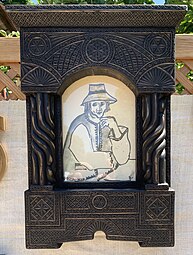
Picture frame sold in the Dimitrie Gusti National Village Museum (Bucharest)

Romanian Revival coffee table from early 20th century, sold in the Artmark Palace

The Magazine of the Holy Synod from March 1927, an example of Romanian Revival graphic design
In addition to architecture, the Romanian Revival style manifested itself in other media, including graphic design, ceramic and furniture. In one of the rooms of the (Bucharest) there is Romanian Romanian furniture, mostly display cases, where ancient Greek and Etruscan vessels are exhibited.
Notable examples[]





Romania[]
- Bucharest
- Nicolae Minovici Villa (Strada Doctor Minovici Nicolae 1)
- Sector 1 Town Hall (Bulevardul Banul Manta 9)
- Gheorghe Tătărescu House (Strada Polonă 19)
- Hagi-Theodoraky House (Șoseaua Kiseleff 57)
- Romanian Peasant Museum (Șoseaua Kisseleff 3)
- (Calea Victoriei 196)
- (Strada Biserica Amzei 12)
- (Strada Ion Movilă 5)
- (Strada Poenaru Bordea 2)
- (Strada Barbu Ștefănescu Delavrancea 6A)
- (Piața Romană 5)
- Interior of the , its exterior being just Eclectic (Strada Arthur Verona 19)
- (Strada Icoanei 3-5)
- (Strada Alexandru Donici 40)
- (Bulevardul Regina Elisabeta 47)
In addition, there are areas in Bucharest where most houses are Romanian Revival, such as Cotroceni and Dorobanți.
- Brașov
- Brașov Opera (Strada Bisericii Române 51)
- Brăila
- Palace of Agriculture (Calea Călărașilor 52)
- Bușteni
- Cantacuzino Castle (Strada Zamora 1)
- Buzău
- City hall (Piața Daciei 1)
- Constanța
- Constanța History and Archaeology Museum (Piața Ovidiu 12)
- (Bulevardul Tomis 32)
- Craiova
- Former Pallace Hotel (Strada Cuza Alexandru Ioan 1)
- Museum of Oltenia (Strada Popa Șapcă 8 - Sciences of Nature, Strada Madona Dudu 14 - Archaeology, Strada Matei Basarab 16 - Ethnography)
- Galați
- Palace of Navigation (Strada Portului 34)
- Iași
- Sonet Villa (Strada Rece 5)
- Oradea
- Iuliu Maniu Greek Catholic College (Strada Iuliu Maniu 5)
- Ploiești
- Ion Luca Caragiale National College (Strada Gheorghe Doja 98)
- National Bank (Strada Tache Ionescu 1)
- Sibiu
- Oașia Building (Strada Turnului 23)
- Faculty of Orthodox Theology (Strada Mitrolopiei 20)
- Gheorghe Lazăr Boarding School building (Strada Turismului 15)
- Târgu Jiu
- Tudor Vladimirescu National College (Strada Unirii 13)
- Timișoara
- Romanian National Opera arcades (Strada Mărășești 2)
Moldova[]
- Bălți
- Saint Constantine and Elena Cathedral
- Residence of the Bishop of Hotin (Strada Visarion Puiu 7)
- Tighina
- Mulmana Hospital
Albania[]
- Sarandë
- Nicolae Iorga House (Rruga Mitat Hoxha), headquarters of the former Romanian Institute in Albania
Bulgaria[]
- Silistra
- Regional History Museum
Ukraine[]
- Khotyn
- House of Culture (Vulytsya Nezalezhnosti, 19-17)
- Chernivtsi
- St. Nikolai Church
- Holy Apostles Peter and Paul Church
- Palace of the border guards
- Priests' dormitory building
See also[]
- Architecture of Romania
- Byzantine Revival architecture
Notes[]
- ^ Paul, Constantin (1977). Mică Enciclopedie de Arhitectură, Arte Decorative și Aplicate Moderne (in Romanian). Editura Științifică și Enciclopedică. p. 109.
- ^ Popescu, Alexandru (2018). Casele și Palatele Bucureștilor (in Romanian). Editura Cetatea de Scaun. p. 69. ISBN 978-606-537-382-2.
- ^ Lucian, Boia (2016). România, Țară de Frontieră a Europei (in Romanian). Humanitas. p. 103 & 104. ISBN 978-973-50-5470-0.
- ^ Popescu, Alexandru (2018). Casele și Palatele Bucureștilor (in Romanian). Editura Cetatea de Scaun. p. 69. ISBN 978-606-537-382-2.
- ^ Paul, Constantin (1977). Mică Enciclopedie de Arhitectură, Arte Decorative și Aplicate Moderne (in Romanian). Editura Științifică și Enciclopedică. p. 109 & 110.
- ^ Paul, Constantin (1977). Mică Enciclopedie de Arhitectură, Arte Decorative și Aplicate Moderne (in Romanian). Editura Științifică și Enciclopedică. p. 110.
External links[]
| Wikimedia Commons has media related to Category:Romanian Revival architecture. |
- Neo-Brâncovenesc architecture
- Architectural styles
- Revival architectural styles





